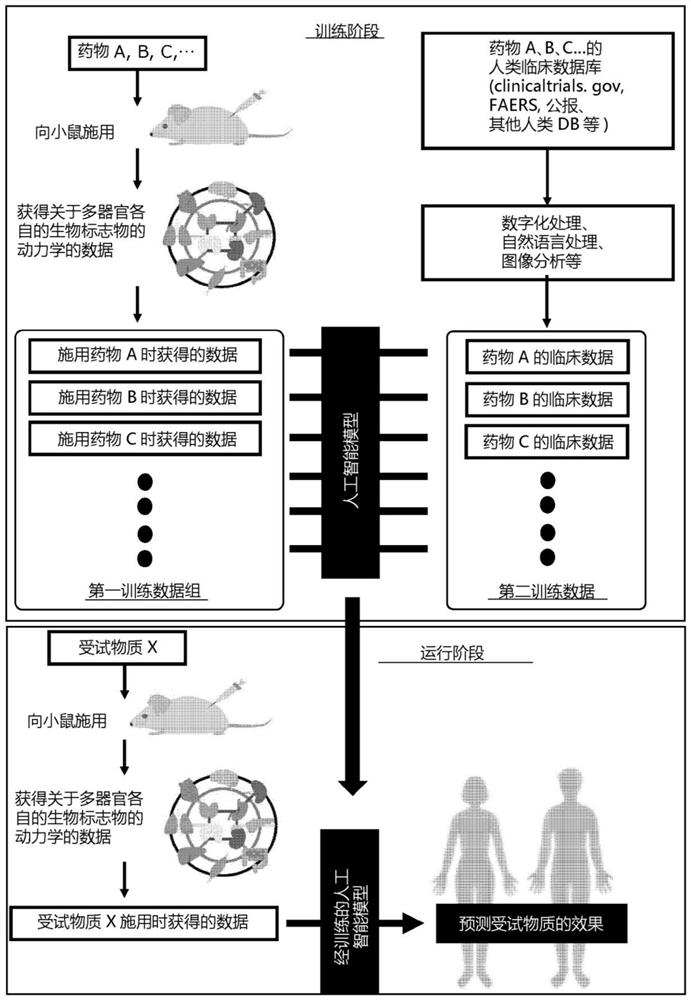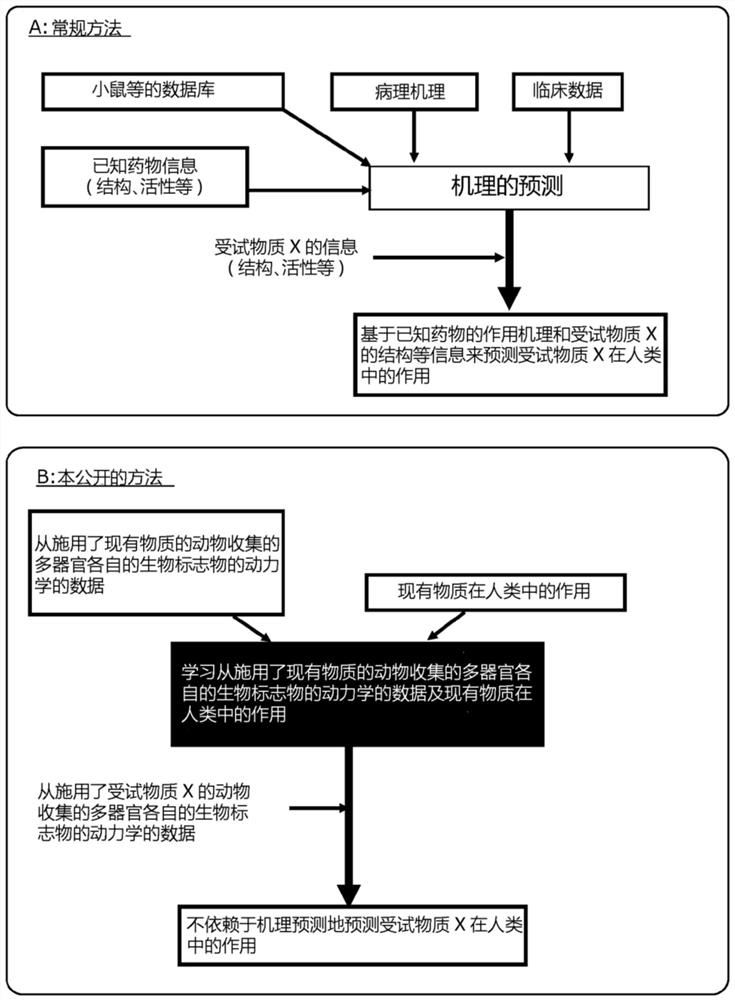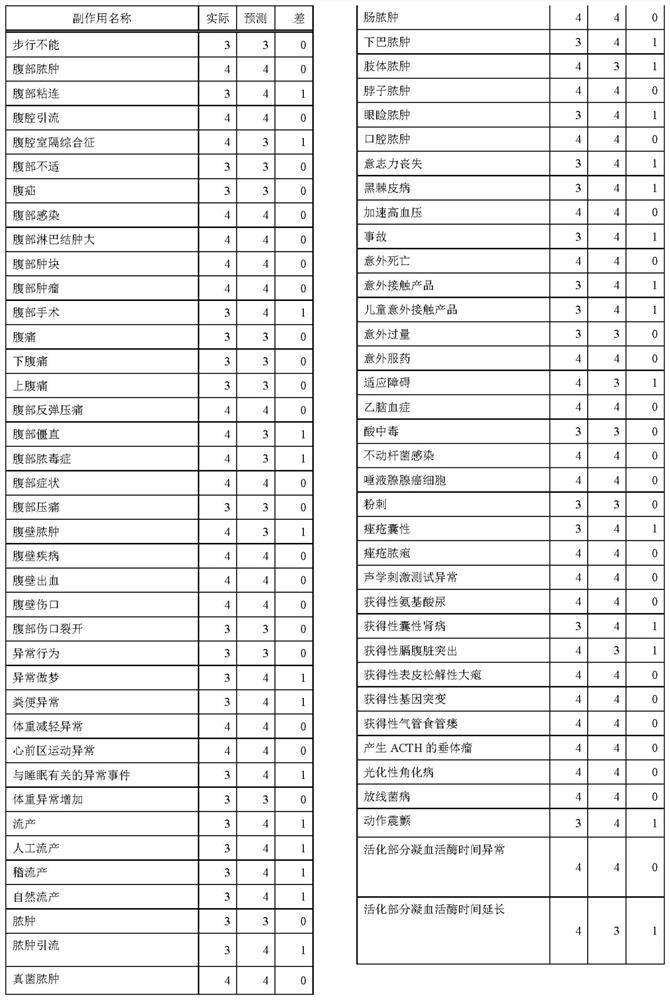Artificial intelligence model for predicting effect of test substance on humans
A technology of artificial intelligence and models, applied in the direction of testing pharmaceutical preparations, biological testing, medical simulation, etc., can solve a lot of time and money problems
- Summary
- Abstract
- Description
- Claims
- Application Information
AI Technical Summary
Problems solved by technology
Method used
Image
Examples
experiment example I
[0322] Experimental Example I: Gene expression analysis in drug-administered mice
[0323] I-1. Preparation of Drug Administration Mice and Analysis of Gene Expression
[0324] (1) Administration of pharmaceuticals
[0325] Administration of Aripiprazole
[0326] Aripiprazole was purchased from Sigma-Aldrich. 10 mg of aripiprazole was mixed with 200 mL of 0.5 w / v% methylcellulose (Wako), and the resulting solution was used for administration.
[0327] Eleven-week-old male C57BL / 6N mice received a single intraperitoneal injection of aripiprazole solution (dose 0.3 mg / kg, administered volume 6 mL / kg). Organs or tissues were removed 2 hours after administration.
[0328] Administration of Empagliflozin
[0329] Empagliflozin (EMPA) was purchased from Toronto Research Chemicals. 50 mg of Empagliflozin was mixed with 25 mL of 0.5 w / v% methylcellulose, and the resulting solution was used for administration.
[0330] 10-week-old male C57BL / 6N mice received oral empagli...
experiment example II
[0420] Experimental Example II: Prediction of Human Action Data Using Drug Administration Mice
[0421] II-1. Construction and prediction of machine learning models using mouse RNA-Seq data and human side effect data
[0422] (1) Generation of mouse data and segmentation of training data and test data
[0423] Changes in gene expression levels (log 2 (multiple)) data (n = 2 for each drug). Since each organ has two data sets (n=2), and people can freely choose which data to use, the number of data items consisting of 24 organs is 2 24 =16777216. Here, data sampling was performed using slightly more than 200 combinations, and data having a scale of (slightly more than 200 samples x 6 pharmaceuticals) x (tens of thousands of organ-gene combinations selected by WGCNA) was obtained in matrix form. Figure 5 An example of a matrix is shown. In order to train the artificial intelligence model and quantify its generalization performance, this matrix is divided into two ...
experiment example III
[0467] Experimental Example III: Selection of Organs Important for Prediction of Each Pharmacokinetic Parameter
[0468] The SVM was used to select organs from non-human animals that had a high predicted contribution to the effect in humans.
[0469] (1) Replication of mouse samples and segmentation of training data and test data
[0470] Changes in gene expression levels (log 2 (multiple)) data (n = 2 for each drug). Since each organ has two data sets (n=2), and people can freely choose which data to use, the number of data items consisting of 24 organs is 2 24 =16777216. Here, data sampling was performed using slightly more than 200 combinations, and data having a scale of (slightly more than 200 samples x 6 pharmaceuticals) x (tens of thousands of organ-gene combinations selected by WGCNA) was obtained in matrix form. In order to train the artificial intelligence model and quantify its generalization performance, the matrix was divided into two matrices, namely, dat...
PUM
 Login to View More
Login to View More Abstract
Description
Claims
Application Information
 Login to View More
Login to View More - R&D
- Intellectual Property
- Life Sciences
- Materials
- Tech Scout
- Unparalleled Data Quality
- Higher Quality Content
- 60% Fewer Hallucinations
Browse by: Latest US Patents, China's latest patents, Technical Efficacy Thesaurus, Application Domain, Technology Topic, Popular Technical Reports.
© 2025 PatSnap. All rights reserved.Legal|Privacy policy|Modern Slavery Act Transparency Statement|Sitemap|About US| Contact US: help@patsnap.com



